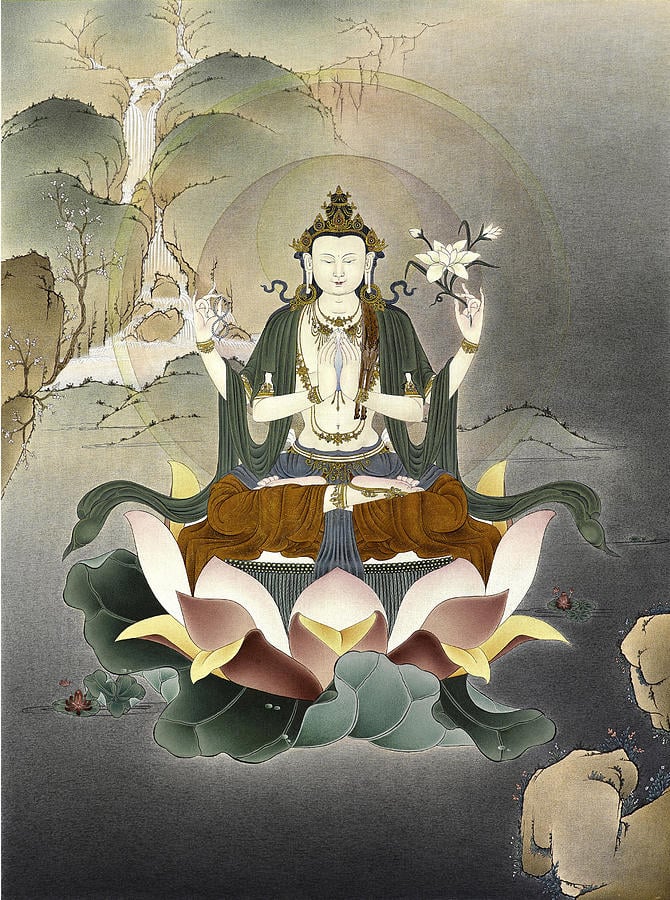The concept of Nirvana is more than 2500 years old. Throughout the centuries, various scholars and philosophers tried to explain this concept using their limited knowledge. In fact, the concept of Nirvana is much more wide and difficult to explain in mundane terms. The Nirvana concept is often misunderstood and sometimes misused in the western world.
The concept of Nirvana was originally explained by the Buddha (566 – 486 B.C.). Gautama Siddartha reached Enlightenment at the age of 35, awakening to the true nature of reality, which is Nirvana (Absolute Truth). The Buddha described the abiding in nirvana as a state of ‘deathlessness’ and as the highest spiritual attainment, the reward for one who lives a life of virtuous conduct. Nibbāna is meant specifically as pertains gnosis that which ends the identity of the mind with empirical phenomena.
The Pāli word Nibbāna (Sanskrit – Nirvana) is composed of “Ni” and “Vāna”. Ni is a negative particle. Vāna means weaving or craving. This craving serves as a cord to connect one life with another. “It is called Nibbāna in that it is a departure (Ni) from that craving which is called Vāna, lusting.” As long as one is bound up by craving or attachment one accumulates fresh Karmic activities which must materialize in one form or other in the eternal cycle of birth and death. When all forms of craving are eradicated, reproductive Karmic forces cease to operate, and one attains Nibbāna, escaping the cycle of birth and death.
The concept of Nirvana (Sanskrit) or Nibbana (Pali) might be translated thus: ‘extinction’, ‘blowing out’, ‘freedom from desire’, the absence of dukkha or to cease. But those words or phrases really don’t explain nirvana. In fact, nirvana is almost unexplainable, and is not perceivable by the six senses. Nirvana can only be explained to the ‘unenlightened’ by negation. However, Nirvana cannot be described as existing, not existing, both existing and not, or neither existing nor not.
The Buddhist conception of Deliverance is the escape from the ever-recurring cycle of life and death and not merely an escape from sin and hell. Nibbāna is also explained as the extinction of the fire of lust (lobha), hatred (dosa), and delusion (moha). Nibbāna, in one sense, may be interpreted as the extinction of these flames. But, in the same time, the extinction of the flames is the mean of attaining Nibbāna.
Anyway, some people say that it is incorrect to think that Nirvana is the natural result of the extinction of craving. Nirvana is not the result of anything. If it would be a result, then it would be an effect produced by a cause. It would be ‘produced’ and ‘conditioned’. Nirvana is neither cause nor effect. It is not produced like a mystic, spiritual, mental state, such as dhyana or samadhi.
Sometimes, Nibbāna is referred to as Sopādisesa Nibbāna Dhātu (nirvana with a remainder) and Anupādisesa Nibbāna Dhātu (nirvana without remainder, or final nirvana). The founder of Buddhism, the Buddha, is believed to have reached both these states. These, in fact, are not two kinds of Nibbāna, but the one single Nibbāna receiving its name according to experience of it before and after death. When Nibbāna is realized in the body, it is called Sopādisesa Nibbāna Dhātu. When an Arahant attains Pari-Nibbāna after the dissolution of the body, without any remainder of any physical existence, it is called Anupādisesa Nibbāna Dhātu.
Nirvana, or the liberation from cycles of rebirth, is the highest aim of the Theravada tradition. In the Mahayana tradition, the highest goal is Buddhahood, in which there is no abiding in Nirvana, but a Buddha continues to take rebirths in the world to help liberate beings from saṃsāra by teaching the Buddhist path.
Nibbāna, a supramundane state, realized by Buddhas and Arahants, is declared to be not conditioned by any cause. Hence it is not subject to any becoming, change and dissolution. It is birthless (ajāta), decayless (ajara), and deathless (amara). Strictly speaking, Nibbāna is neither a cause nor an effect. Hence it is unique (kevala).
According to Buddhism, Nirvana is a complex conceptual state of being in which a person escapes the suffering of the world and realizes his or her oneness with the universe. The person whose consciousness enters Nirvana can eventually leave behind the cycle of reincarnation to exist spiritually, albeit impersonally. The final goal of Buddhism is Nirvana, when the “quenching” of all desire is complete, and the person is transformed into another state.
Nibbāna, being non-conditioned, is eternal, (dhuva), desirable (subha), and happy (sukha). The happiness of Nibbāna should be differentiated from ordinary worldly happiness. Nibbānic bliss grows neither stale nor monotonous. It is a form of happiness that never wearies, never fluctuates. It arises by allaying passions (vupasama) unlike that temporary worldly happiness which results from the gratification of some desire (vedayita).
An important facet of Nirvana is that it is not something that comes about from a concatenation of causes, that springs into existence as a result of an act of creation or an agglomeration of causative factors: it was never created; it always was, is and will be. But due to the moral and mental darkness of ordinary, samsarically benighted sentient beings, it remains hidden from unawakened perception.
The explanation of Nirvana in Mahayana Mahaparinirvana Sutra is as follows:
“O, good man! We speak of “Nirvana”. But this is not “Great” “Nirvana”. Why is it “Nirvana”, but not “Great Nirvana”? This is so when one cuts away defilement without seeing the Buddha-Nature. That is why we say Nirvana, but not Great Nirvana. When one does not see the Buddha-Nature, what there is is the non-Eternal and the non-Self. All that there is is but Bliss and Purity. Because of this, we cannot have Mahaparinirvana, although defilement has been done away with. When one sees well the Buddha-Nature and cuts away defilement, we then have Mahaparinirvana. Seeing the Buddha-Nature, we have the Eternal, Bliss, the Self, and the Pure. Because of this, we can have Mahaparinirvana, as we cut away defilement.”
Photo credit: t4nuki




